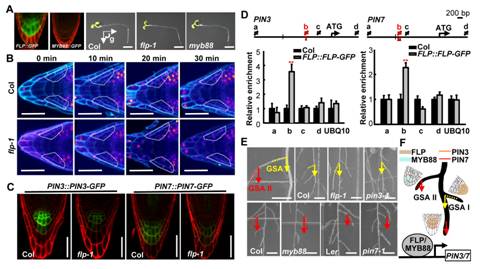Why Roots Grow Vertically? The importance of gravitropism to plant development had been answered by the biologist Charles Robert Darwin around one century ago. The distribution of root system in the soil directly affects the absorption and the usage of nutrients and water. PIN proteins are auxin export carriers that direct intercellular auxin flow and in turn regulate many aspects of plant growth and development including responses to environmental changes. The Arabidopsis R2R3-MYB transcription factor FOUR LIPS (FLP) and its paralogue MYB88 regulate terminal divisions during stomatal development, as well as female reproductive development and stress responses. Prof. LE Jie’s group in the Institute of Botany, the Chinese Academy of Sciences, recently reported that FLP and MYB88 act redundantly but differentially in regulating the transcription of PIN3 and PIN7 in gravity-sensing cells of primary and lateral roots. On the one hand, FLP is involved in responses to gravity stimulation in primary roots, whereas on the other, FLP and MYB88 function complementarily in establishing the gravitropic set-point angles of lateral roots. These results support a model in which FLP and MYB88 expression specifically determines the temporal-spatial patterns of PIN3 and PIN7 transcription that are closely associated with their preferential functions during root responses to gravity, suggesting that root growth responses to gravity are essential for root architecture in soil, which affects the efficiency of nutrients and water absorption.
This work is published on Nature Communications on November 18, 2015. WANG Hongzhe in LE’s group is the first author of this paper. A co-authored article about PIN3 in regulating lateral root initiation is published at meantime (Chen et al., 2015 Nat. Commun. 6:8821). This research was supported by grants from the National Basic Research Program of China, and the National Natural Science Foundation of China.

Figure 1. Coordination of FLP and MYB88 in regulating transcripts of PINs in the gravity-sensing cell of Arabidopsis roots.
(A) Specific expression of FLP in gravity-sensing cells of primary roots. Primary roots of flp-1 display defective responses to gravity stimulation. Expression of MYB88 is absent from primary root tip. (B) Auxin asymmetric redistribution is delayed in flp-1 root after gravity stimulation (DII-VENUS). (C) The expression of PIN3 and PIN7 is suppressed in gravity-sensing cells of flp primary roots. (D) FLP and MYB88 regulate transcripts of PIN3 and PIN7. (E) Lateral roots from flp-1 and myb88 display a smaller GSA, which mimic pin3 and pin7, respectively. (F) A diagram of the coordination of FLP and MYB88 in regulating PIN3 and PIN7 transcripts during root gravitropism.
Article links:
http://www.nature.com/ncomms/2015/151118/ncomms9822/full/ncomms9822.html
http://www.nature.com/ncomms/2015/151118/ncomms9821/full/ncomms9821.html
Contact information
Prof. LE Jie
Key Laboratory of Plant Molecular Physiology
Institute of Botany, Chinese Academy of Sciences, Beijing 100093, China
e-mail: lejie@ibcas.ac.cn
http://www.klpmp.net/ktz_display.asp?ktid=37&ktclass=1
Why Roots Grow Vertically? The importance of gravitropism to plant development had been answered by the biologist Charles Robert Darwin around one century ago. The distribution of root system in the soil directly affects the absorption and the usage of nutrients and water. PIN proteins are auxin export carriers that direct intercellular auxin flow and in turn regulate many aspects of plant growth and development including responses to environmental changes. The Arabidopsis R2R3-MYB transcription factor FOUR LIPS (FLP) and its paralogue MYB88 regulate terminal divisions during stomatal development, as well as female reproductive development and stress responses. Prof. LE Jie’s group in the Institute of Botany, the Chinese Academy of Sciences, recently reported that FLP and MYB88 act redundantly but differentially in regulating the transcription of PIN3 and PIN7 in gravity-sensing cells of primary and lateral roots. On the one hand, FLP is involved in responses to gravity stimulation in primary roots, whereas on the other, FLP and MYB88 function complementarily in establishing the gravitropic set-point angles of lateral roots. These results support a model in which FLP and MYB88 expression specifically determines the temporal-spatial patterns of PIN3 and PIN7 transcription that are closely associated with their preferential functions during root responses to gravity, suggesting that root growth responses to gravity are essential for root architecture in soil, which affects the efficiency of nutrients and water absorption.
This work is published on Nature Communications on November 18, 2015. WANG Hongzhe in LE’s group is the first author of this paper. A co-authored article about PIN3 in regulating lateral root initiation is published at meantime (Chen et al., 2015 Nat. Commun. 6:8821). This research was supported by grants from the National Basic Research Program of China, and the National Natural Science Foundation of China.

Figure 1. Coordination of FLP and MYB88 in regulating transcripts of PINs in the gravity-sensing cell of Arabidopsis roots.
(A) Specific expression of FLP in gravity-sensing cells of primary roots. Primary roots of flp-1 display defective responses to gravity stimulation. Expression of MYB88 is absent from primary root tip. (B) Auxin asymmetric redistribution is delayed in flp-1 root after gravity stimulation (DII-VENUS). (C) The expression of PIN3 and PIN7 is suppressed in gravity-sensing cells of flp primary roots. (D) FLP and MYB88 regulate transcripts of PIN3 and PIN7. (E) Lateral roots from flp-1 and myb88 display a smaller GSA, which mimic pin3 and pin7, respectively. (F) A diagram of the coordination of FLP and MYB88 in regulating PIN3 and PIN7 transcripts during root gravitropism.
Article links:
http://www.nature.com/ncomms/2015/151118/ncomms9822/full/ncomms9822.html
http://www.nature.com/ncomms/2015/151118/ncomms9821/full/ncomms9821.html
Contact information
Prof. LE Jie
Key Laboratory of Plant Molecular Physiology
Institute of Botany, Chinese Academy of Sciences, Beijing 100093, China
e-mail: lejie@ibcas.ac.cn
http://www.klpmp.net/ktz_display.asp?ktid=37&ktclass=1
